Baltimore Artist Mequitta Ahuja on How Her New Exhibition Is an Ode to Motherhood and Loss
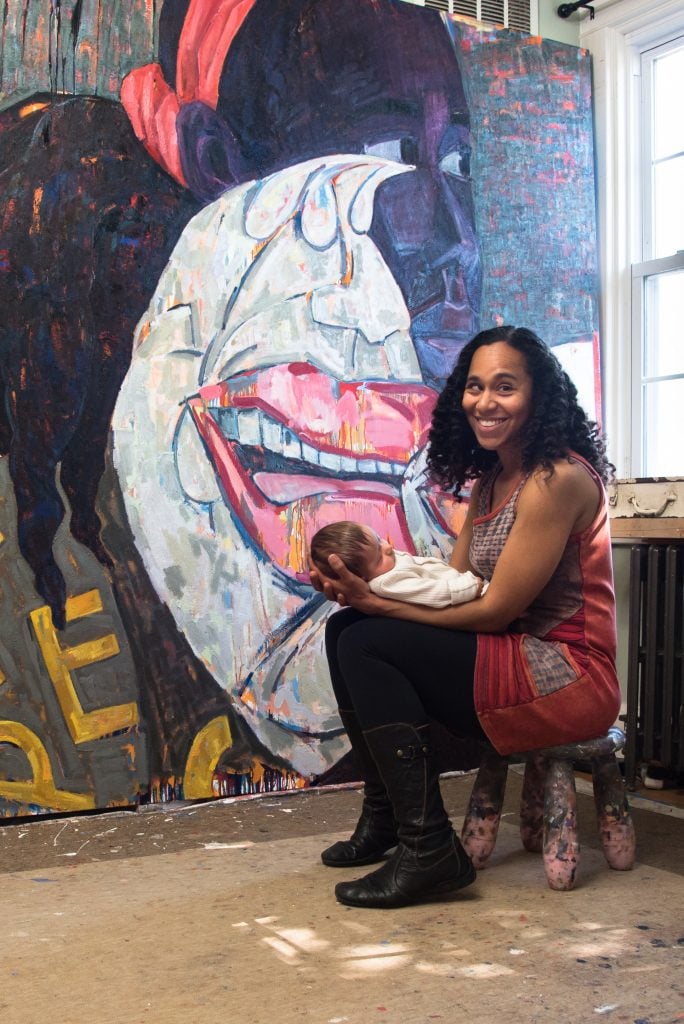

Katie White

“I make paintings by scraping away paint, figuring something new out of loss. What’s left behind, that’s the painting,” says Mequitta Ahuja, a Baltimore-based artist known for her self-portraits that draw inspiration from art history, literature, and her own experiences as a woman of Indian and African American parents growing up in a mostly white suburban neighborhood.
“Ma”, the artist’s new exhibition at New York’s Aicon Gallery, includes 20 oil sketches and five large oil paintings. The works may be the artist’s most intimately personal yet—made over the past 15 months, during the final period of her mother Sonja’s life, the works are a form of grieving. Loss, healing, gratitude, and connection exist as interconnected and equal energies.
Recently, the artist shared insight into the series while also fielding questions about her art-historical inspirations, and how Doris Lessing’s The Golden Notebook has influenced her approach to artmaking.

The artist with her mother, Sonja.
The works in “Ma” reflect on the life of your mother, Sonja. Can you tell me more about the works and the process of creating them?
As source material, I revisited a series of photographic studies I made as an art student of myself and my mother in which the two of us are naked, pushing and pulling each other. Maintaining my signature strategy of auto-referential figuration, I expanded my representational system to include the image and body of my mother.
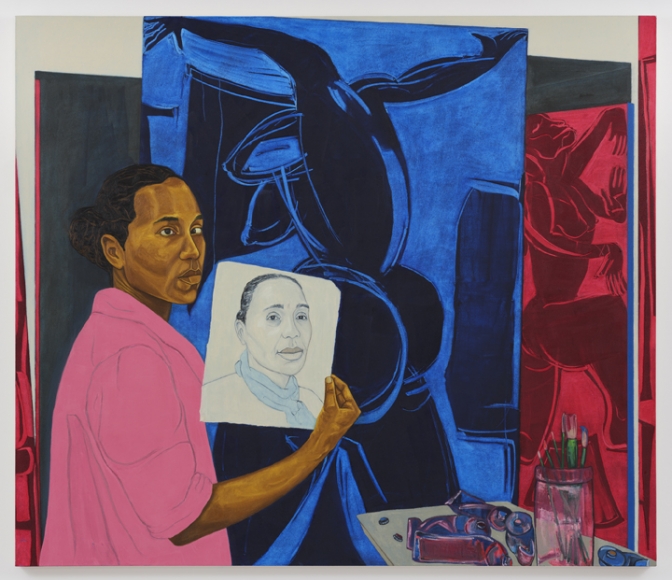
Mequitta Ahuja, Portrait of Her Mother (2020). Courtesy of Aicon Gallery.
In two of the five canvases on display, I combine my new subtractive method with the additive process I have worked with in the past. In Portrait of Her Mother and Primary Love, I depict myself holding, and presenting to the viewer, pictures of my mother. In these paintings, I pursue an overtly narrative approach, using painting as a kind of text to convey all of the relevant information a viewer requires to deeply understand the origins and intended meanings of the works on display.
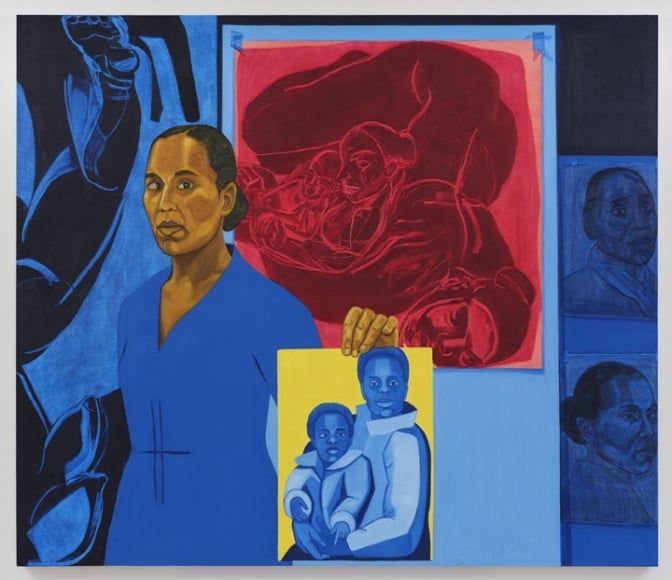
Mequitta Ahuja, Primary Love (2020). Courtesy of Aicon Gallery.
If you had to describe your body of work in three sentences, what would you say?
What are the most essential tools in your studio?
“The Panda Cam”—that’s what my husband and I call our baby monitor. Electric lights as I’m a morning person… a really early morning person. And patience, which is hard-won since it’s not my natural character.
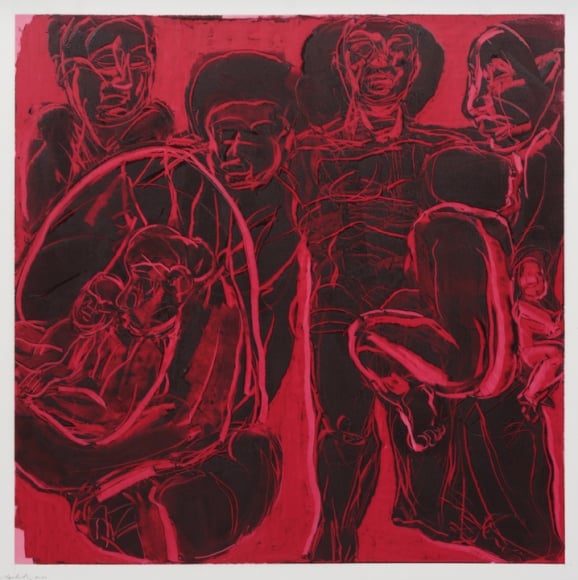
Mequitta Ahuja, Emerge (2020). Courtesy of Aicon Gallery.
Do you have a favorite time of day to work?
I have always been a morning person. I go to bed when my two-year-old goes to bed. I sleep for seven to eight hours. He sleeps eleven. I exploit that difference. I work from 5 to 8 a.m. before he wakes, from 10 a.m. to noon while we have childcare, and then again from 1:30-3 while our son naps. My husband—a night owl—and I also give each other time to work. Depending on the day, I spend between five and eight hours in the studio. I spend that time drawing, thinking, looking, writing, reading, and painting.
You come from an Indian and African-American background, but, as I read, grew up in a mostly white environment. Can you tell me about that? How do these identities and experiences influence your work, if at all?
I grew up within two cultural spaces: my white, liberal, upper-middle-class town, and a local Indian community comprised of immigrants and their U.S. born children. I could recognize my father and his cohort of Indian immigrants and their social position and attitudes recently described by Arun Venugopal in the recent Atlantic article “The Truth Behind Indian American Exceptionalism.” Our mother, who died this past May, was African-American and she, my sister, and I were the only Black members of this clique.
As for me, I respond to our society’s siloed social categories by indulging my innate hermetic tendencies. I have always felt/been apart. That’s okay with me; I embrace it. Taken as a whole, my artwork reveals a timeline of my relationship to the various social categories I find myself in.
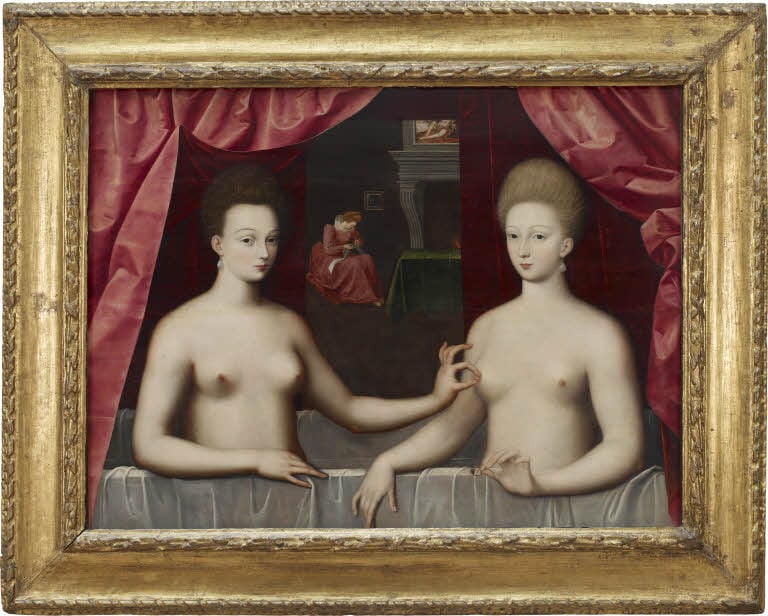
Gabrielle d’Estrées and One of Her Sisters (circa 1594). Anonymous. Collection of the Louvre.
Considering your artwork is so engaged with questions of female representation, can you tell me a few portraits of women from art history that interest you most?
I got the idea of announcing my 2018 pregnancy with a painting from a strange historical precedent: Gabrielle d’Estrées and One of Her Sisters. Little is known about this portrait of sisters, but it is presumed to be an announcement of the pregnancy of Gabrielle d’Estrees, mistress of King Henry IV of France.
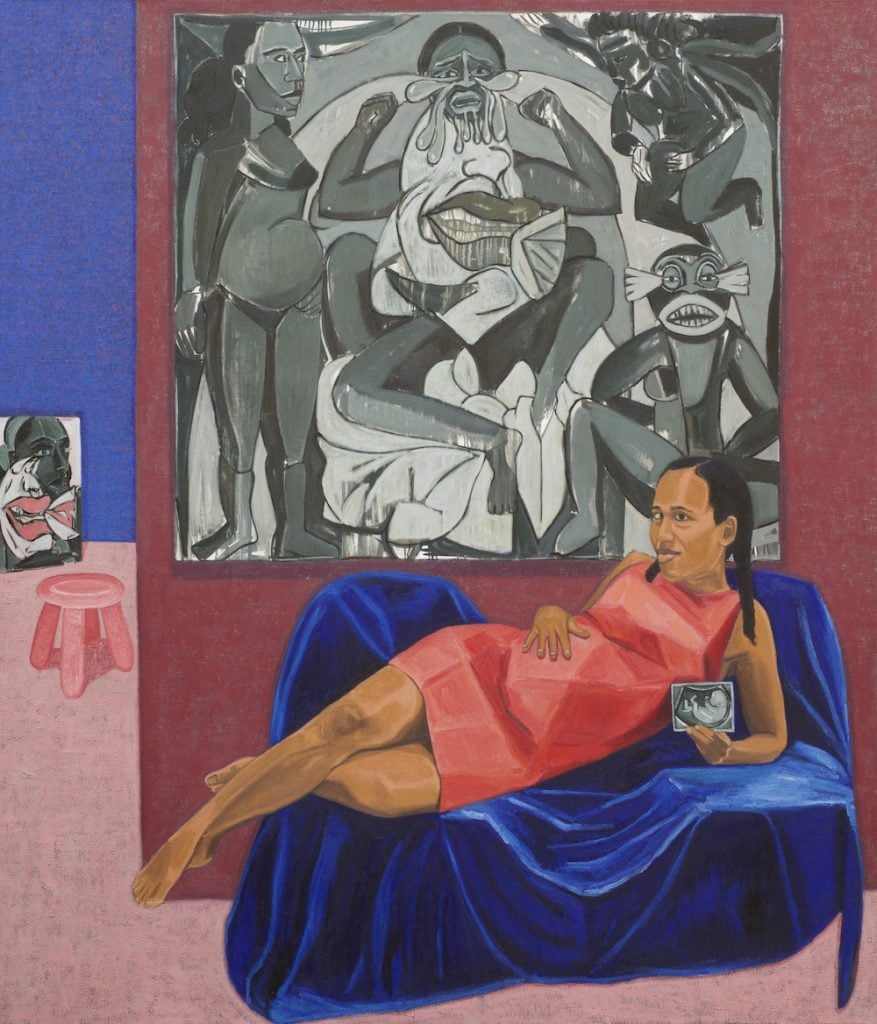
Mequitta Ahuja, Xpect (2018). Courtesy of the artist.
While the meaning of the pinching fingers gesture (representing pregnancy) may have been understood by likely viewers of the painting at the time, it is now, startlingly intimate and strange.

Hans Holbein, Portrait of an Unknown Lady (16th century).
The clarity and simplicity of Hans Holbein’s draughtsmanship, as seen in his portrait of an unknown woman, is a recent discovery for me, and deeply instructive as I aim to use pictorial means with absolute purpose and power.

Jean-Auguste-Dominique Ingres, The Princesse de Broglie (1851–1853). Collection of the Metropolitan Museum of Art.
To me, this Ingres painting embodies the height of images from history of a kind of idealized woman–her porcelain skin, her dress. In 2015, I wanted to integrate an element of that work in order to incorporate and reinterpret its connotations of beauty and luxury into my painting, so I included a swath of fabric in my painting Fingering Vanitas, as a kind of skinning or amputation from the Ingres painting.

Mequitta Ahuja, Fingering Vanitas (2015). Courtesy of the artist.
Are there any thinkers or philosophers who inspire you particularly?
I consume a lot of fiction and non-fiction. Just a few of the most illuminating non-fiction books I listened to in 2020 are:
Angela Saini’s Superior: The Return of Race Science, which clarified the slow erosion of truth perpetuated by companies like 23andMe and racialized medicine.
Robin Corey’s The Enigma of Clarence Thomas, which introduced me to the theory of Afropessimism.
Siddhartha Muhkerjee’s The Emperor of All Maladies, which gave me perspective on the disease that killed my mother.
Aside from other artists, can you tell me a little bit about how literature and certain writers have impacted your practice?
In my paintings within paintings, I aim to achieve something similar to what Doris Lessing achieved in The Golden Notebook, her 1962 novel about living in the world as a woman and an artist. Through her main character’s color-coded notebooks each with a specific writing style and purpose, Lessing shows the complex interrelation of the artist’s experiences, feelings, intellect, and craft, thereby enacting the relationship between art and its genesis.
Using paintings within paintings, I enact the same. While in my works, I make direct reference to different genres as well as to specific paintings from history, I filter each reference through my own creative response. The artworks I depict are my own.

Sherwin Ovid, The Cult of My Black Mother. Courtesy of the artist and Mequitta Ahuja.
If you could own any artwork in the world (no restrictions) what would it be?
I own it! Sherwin Ovid’s The Cult of My Black Mother.
“Ma” is on view at Aicon Gallery through January 23, 2021.